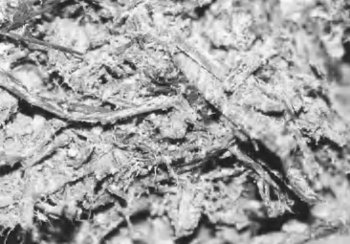Spawning
On bed farms, spawn and supplement are broadcast over the surface of the substrate. Uniformity of this distribution is critical to achieve even spawn growth and temperatures. On tray or bulk farms, spawn is usually metered into the substrate during the mixing operation. Spawning is the cleanest operation performed on a mushroom farm. All equipment, baskets, tools, and so forth should be thoroughly cleaned and disinfected before spawning.
The amount of spawn used depends on the length of the spawn-growing period and compost fill weights. The use of more spawn will result in a quicker colonization and more efficient use of substrate nutrients. Improved colonization of substrate will help ensure that the mushroom mycelia will grow quicker than other fungal competitors.
During the spawn-growing period, heat is generated and supplemental cooling is required. Substrate temperatures should be maintained at 75–77ºF and relative humidity should be high to minimize drying of the substrate surface. Under proper conditions, the spawn will grow as a delicate network of mycelia throughout the substrate. The mycelium grows in all directions from a spawn grain. Eventually mycelia from different spawn grains fuse together, making a spawned bed appear as a white root-like network throughout the compost (Figure 12). As the spawn grows, it generates heat. If the compost temperature increases to above 80° or 85°F, depending on the cultivar, the heat may kill or damage the mycelia, reducing crop yield and/or mushroom quality. The time needed for spawn to colonize the compost depends on the spawning rate and its distribution, the compost moisture and temperature, and the nature or quality of the compost. A complete spawn run usually requires 14 to 21 days. The spawn-growing period is considered complete when spawn has completely colonized the substrate and the metabolic heat surge is subsiding.

Figure 12. Handful of mushroom substrate showing fully colonized spawn growth.
4218 view.